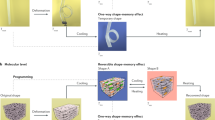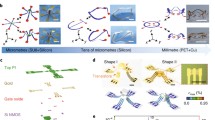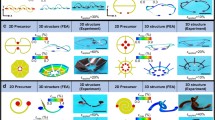Abstract
Three-dimensional (3D) mesostructures with distinct compressive deformation behaviors and tunable mechanical responses have gained increasing interest in recent years. 3D cage-shaped mesostructures are representative framework structures widely exploited in 3D flexible electronics, owing to their unique cellular geometry and unusual mechanical responses. The snap-through behavior of cage-shaped mesostructures could potentially result in the performance degradation of electronics, while it could also be harnessed to design reconfigurable electronics. Due to the complicated deformation modes and random characteristics in experiments, the snap-through behavior of cage-shaped mesostructures remains largely unexplored, especially in terms of probability-based analyses. In this work, we present a systematic study on the configuration evolution and snap-through of 3D cage-shaped mesostructures under out-of-plane compressions. Experimental and computational studies show the existence of two distinct deformation modes associated with the snap-through, which is controlled by the energy barrier based on the energetic analyses. Phase diagrams of the deformation modes decode how key geometric parameters and assembly strain affect the snap-through. Compressive experiments based on periodic arrays (10 × 10) of mesostructures provided a large amount of deformation data, allowing for statistical analyses of the snap-through behavior. These results provide new insights and useful guidelines for the design of 3D reconfigurable devices and multistable metamaterials based on 3D cage-shaped mesostructures.








Similar content being viewed by others
Data Availability Statement
All data generated or analyzed used to support the findings of this study are included within the article.
References
Zhang H, Wu J, Fang D, et al. Hierarchical mechanical metamaterials built with scalable tristable elements for ternary logic operation and amplitude modulation. Sci Adv. 2021;7(9):eabf1966.
Luo G, Fu H, Cheng X, et al. Mechanics of bistable cross-shaped structures through loading-path controlled 3D assembly. J Mech Phys Solids. 2019;129:261–77.
Taffetani M, Jiang X, Holmes DP, et al. Static bistability of spherical caps. Proc Math Phys Eng Sci. 2018;474(2213):20170910.
Zhang Y, Jiao Y, Wu J, et al. Configurations evolution of a buckled ribbon in response to out-of-plane loading. Extrem Mech Lett. 2020;34:100604.
Liu W, Jiang H, Chen Y. 3D programmable metamaterials based on reconfigurable mechanism modules. Adv Funct Mater. 2021;32(9):2109865.
Pang W, Cheng X, Zhao H, et al. Electro-mechanically controlled assembly of reconfigurable 3D mesostructures and electronic devices based on dielectric elastomer platforms. Natl Sci Rev. 2020;7(2):342–54.
Lahikainen M, Zeng H, Priimagi A. Reconfigurable photoactuator through synergistic use of photochemical and photothermal effects. Nat Commun. 2018;9(1):4148.
Lou Z, Wang L, Jiang K, et al. Programmable three-dimensional advanced materials based on nanostructures as building blocks for flexible sensors. Nano Today. 2019;26:176–98.
Cai M, Nie S, Du Y, et al. Soft elastomers with programmable stiffness as strain-isolating substrates for stretchable electronics. ACS Appl Mater Interfaces. 2019;11(15):14340–6.
Luan H, Zhang Y. Programmable stimulation and actuation in flexible and stretchable electronics. Adv Intell Syst. 2021;3(6):2000228.
Guo X, Xu Z, Zhang F, et al. Reprogrammable 3D mesostructures through compressive buckling of thin films with prestrained shape memory polymer. Acta Mech Solida Sin. 2018;31(5):589–98.
Zhai Z, Wang Y, Lin K, et al. In situ stiffness manipulation using elegant curved origami. Sci Adv. 2020;6:eabe2000.
Jia Z, Li T. Effect of interfacial stiffness on the stretchability of metal/elastomer bilayers under in-plane biaxial tension. Theor Appl Mech Lett. 2021;11(3):100247.
Zhou Y, Zhang W, Hu J, et al. The stiffness-threshold conflict in polymer networks and a resolution. J Appl Mech. 2020;87(3):031002.
Yang H, Ma L. 1D to 3D multi-stable architected materials with zero Poisson’s ratio and controllable thermal expansion. Mater Des. 2020;188:108430.
Li Y, Luo S, Yang MC, et al. Poisson ratio and piezoresistive sensing: a new route to high-performance 3D flexible and stretchable sensors of multimodal sensing capability. Adv Funct Mater. 2016;26(17):2900–8.
Zhu Y, Schenk M, Filipov ET. A review on origami simulations: from kinematics, to mechanics, toward multiphysics. Appl Mech Rev. 2022;74(3):030801.
Ma Q, Cheng H, Jang KI, et al. A nonlinear mechanics model of bio-inspired hierarchical lattice materials consisting of horseshoe microstructures. J Mech Phys Solids. 2016;90:179–202.
Ma Q, Zhang Y. Mechanics of fractal-inspired horseshoe microstructures for applications in stretchable electronics. J Appl Mech. 2016;83(11):111008.
Yan D, Chang J, Zhang H, et al. Soft three-dimensional network materials with rational bio-mimetic designs. Nat Commun. 2020;11(1):1180.
Wang T, Yang Y, Xu F. Mechanics of tension-induced film wrinkling and restabilization—a review. Proc Math Phys Eng Sci. 2022;478(2263):20220149.
Liu J, Zhu X, Shen Z, et al. Imperfection sensitivity of mechanical properties in soft network materials with horseshoe microstructures. Acta Mech Sin. 2021;37(7):1050–62.
Liu T, Asheghi M, Goodson KE. Performance and manufacturing of silicon-based vapor chambers. Appl Mech Rev. 2021;73(1):010802.
Chen AL, Wang YS, Wang YF, et al. Design of acoustic/elastic phase gradient metasurfaces: principles, functional elements, tunability, and coding. Appl Mech Rev. 2022;74(2):020801.
Shi J, Liu S, Zhang L, et al. Smart textile-integrated microelectronic systems for wearable applications. Adv Mater. 2020;32(5):e1901958.
Song H, Luo G, Ji Z, et al. Highly-integrated, miniaturized, stretchable electronic systems based on stacked multilayer network materials. Sci Adv. 2022;8(11):eabm3785.
Zhou H, Zhang Y, Qiu Y, et al. Stretchable piezoelectric energy harvesters and self-powered sensors for wearable and implantable devices. Biosens Bioelectron. 2020;168:112569.
Dong L, Jin C, Closson AB, et al. Cardiac energy harvesting and sensing based on piezoelectric and triboelectric designs. Nano Energy. 2020;76:105076.
Han M, Wang H, Yang Y, et al. Three-dimensional piezoelectric polymer microsystems for vibrational energy harvesting, robotic interfaces and biomedical implants. Nat Electron. 2019;2(1):26–35.
Chen B, Tang W, Wang ZL. Advanced 3D printing-based triboelectric nanogenerator for mechanical energy harvesting and self-powered sensing. Mater Today. 2021;50:224–38.
Yang L, Liu C, Yuan W, et al. Fully stretchable, porous MXene-graphene foam nanocomposites for energy harvesting and self-powered sensing. Nano Energy. 2022;103:107807.
Zhang H, Sun F, Cao G, et al. Bifunctional flexible electrochromic energy storage devices based on silver nanowire flexible transparent electrodes. Int J Extreme Manuf. 2022;5(1):015503.
Jin L, Khajehtourian R, Mueller J, et al. Guided transition waves in multistable mechanical metamaterials. Proc Natl Acad Sci USA. 2020;117(5):2319–25.
Zhang H, Guo X, Wu J, et al. Soft mechanical metamaterials with unusual swelling behavior and tunable stress-strain curves. Sci Adv. 2018;4(6):eaar8535.
Zheng X, Lee H, Weisgraber TH, et al. Ultralight, ultrastiff mechanical metamaterials. Science. 2014;344(6190):1373–7.
Taylor JM, Luan H, Lewis JA, et al. Biomimetic and biologically compliant soft architectures via 3D and 4D assembly methods: a perspective. Adv Mater. 2022;34(16):e2108391.
Ling Y, Pang W, Liu J, et al. Bioinspired elastomer composites with programmed mechanical and electrical anisotropies. Nat Commun. 2022;13(1):524.
Zhang Y, Zhang F, Yan Z, et al. Printing, folding and assembly methods for forming 3D mesostructures in advanced materials. Nat Rev Mater. 2017;2(4):17019.
Gu G, Xu H, Peng S, et al. Integrated soft ionotronic skin with stretchable and transparent hydrogel–elastomer ionic sensors for hand-motion monitoring. Soft Robot. 2019;6(3):368–76.
Li M, Li X, Che L, et al. Non-uniform global-buckling and local-folding in thin film of stretchable electronics. Int J Mech Sci. 2020;175:105537.
Luo H, Wang C, Linghu C, et al. Laser-driven programmable non-contact transfer printing of objects onto arbitrary receivers via an active elastomeric microstructured stamp. Natl Sci Rev. 2020;7(2):296–304.
Chen H, Zhu F, Jang KI, et al. The equivalent medium of cellular substrate under large stretching, with applications to stretchable electronics. J Mech Phys Solids. 2018;120:199–207.
Yin Y, Li M, Li Y, et al. Skin pain sensation of epidermal electronic device/skin system considering non-Fourier heat conduction. J Mech Phys Solids. 2020;138:103927.
Wang H, Zhao Z, Liu P, et al. Laser-induced porous graphene on Polyimide/PDMS composites and its kirigami-inspired strain sensor. Theor Appl Mech Lett. 2021;11(2):100240.
Zhao J, Zhang F, Guo X, et al. Torsional deformation dominated buckling of serpentine structures to form three-dimensional architectures with ultra-low rigidity. J Mech Phys Solids. 2021;155:104568.
Zhang J, Li Y, Xing Y. Theoretical and experimental investigations of transient thermo-mechanical analysis on flexible electronic devices. Int J Mech Sci. 2019;160:192–9.
Wang FF, Wang T, Zhang X, et al. Wrinkling of twisted thin films. Int J Solids Struct. 2023;262–263:112075.
Xu S, Yan Z, Jang KI, et al. Assembly of micro/nanomaterials into complex, three-dimensional architectures by compressive buckling. Science. 2015;347(6218):154–9.
Xue Z, Song H, Rogers JA, et al. Mechanically-guided structural designs in stretchable inorganic electronics. Adv Mater. 2020;32(15):e1902254.
Guo X, Xue Z, Zhang Y. Manufacturing of 3D multifunctional microelectronic devices: challenges and opportunities. NPG Asia Mater. 2019;11(1):29.
Shuai Y, Zhao J, Bo R, et al. A wrinkling-assisted strategy for controlled interface delamination in mechanically-guided 3D assembly. J Mech Phys Solids. 2023;173:105203.
Zhang Y, Yan Z, Nan K, et al. A mechanically driven form of Kirigami as a route to 3D mesostructures in micro/nanomembranes. Proc Natl Acad Sci USA. 2015;112(38):11757–64.
Xue Z, Jin T, Xu S, et al. Assembly of complex 3D structures and electronics on curved surfaces. Sci Adv. 2022;8(32):eabm6922.
Luan H, Cheng X, Wang A, et al. Design and fabrication of heterogeneous, deformable substrates for the mechanically guided 3D assembly. ACS Appl Mater Interfaces. 2019;11(3):3482–92.
Cheng X, Zhang Y. Micro/nanoscale 3D assembly by rolling, folding, curving, and buckling approaches. Adv Mater. 2019;31(36):e1901895.
Cheng X, Liu Z, Jin T, et al. Bioinspired design and assembly of a multilayer cage-shaped sensor capable of multistage load bearing and collapse prevention. Nanotechnology. 2021;32(15):155506.
Fan Z, Hwang KC, Rogers JA, et al. A double perturbation method of postbuckling analysis in 2D curved beams for assembly of 3D ribbon-shaped structures. J Mech Phys Solids. 2018;111:215–38.
Yan Z, Han M, Shi Y, et al. Three-dimensional mesostructures as high-temperature growth templates, electronic cellular scaffolds, and self-propelled microrobots. Proc Natl Acad Sci USA. 2017;114(45):E9455–64.
Zhao H, Cheng X, Wu C, et al. Mechanically guided hierarchical assembly of 3D mesostructures. Adv Mater. 2022;34(12):e2109416.
Lee Y, Myoung J, Cho S, et al. Bioinspired gradient conductivity and stiffness for ultrasensitive electronic skins. ACS Nano. 2021;15(1):1795–804.
Wang X, Guo X, Ye J, et al. Freestanding 3D mesostructures, functional devices, and shape-programmable systems based on mechanically induced assembly with shape memory polymers. Adv Mater. 2019;31(2):e1805615.
Humood M, Shi Y, Han M, et al. Fabrication and deformation of 3D multilayered kirigami microstructures. Small. 2018;14(11):e1703852.
Humood M, Lefebvre J, Shi Y, et al. Fabrication and mechanical cycling of polymer microscale architectures for 3D MEMS sensors. Adv Eng Mater. 2019;21(3):1801254.
Cheng X, Zhang Y. Nonlinear compressive deformations of buckled 3D ribbon mesostructures. Extrem Mech Lett. 2021;42:101114.
Katz S, Givli S. The post-buckling behavior of a beam constrained by springy walls. J Mech Phys Solids. 2015;78:443–66.
Fu H, Nan K, Bai W, et al. Morphable 3D mesostructures and microelectronic devices by multistable buckling mechanics. Nature Mater. 2018;17(3):268–76.
Zhao Z, Liu J, Soh AK, et al. On the snap-through time of a nanoscale elastic strip. Acta Mech Sin. 2022;38(4):121219.
Acknowledgements
Y.Z. acknowledges support from the National Natural Science Foundation of China (grant nos. 12225206, 12050004 and 11921002), the Tsinghua National Laboratory for Information Science and Technology, the Henry Fok Education Foundation (Grant no. 171003), and a grant from the Institute for Guo Qiang, Tsinghua University (Grant no. 2019GQG1012).
Funding
National Natural Science Foundation of China, 12225206, Yihui Zhang, 12050004, Yihui Zhang, 11921002, Yihui Zhang, the Tsinghua National Laboratory for Information Science and Technology, the Henry Fok Education Foundation, 171003, Yihui Zhang, the Institute for Guo Qiang, Tsinghua University, 2019GQG1012, Yihui Zhang.
Author information
Authors and Affiliations
Contributions
YZ and XC designed the research; QL led the fabrication work and the experimental characterization with assistance from ZS, XC, ZL, YS, ZL and TJ; ZS led the structural designs, theoretical modeling and FEA predictions with assistance from XC; YZ, XC, QL, and ZS wrote the text and designed the figures; YZ supervised the research. All authors commented on the paper.
Corresponding authors
Ethics declarations
Conflict of interest
The authors declare that they have no competing interests.
Consent for Publication
All authors approve the manuscript and give their consent for submission and publication.
Supplementary Information
Below is the link to the electronic supplementary material.
Rights and permissions
Springer Nature or its licensor (e.g. a society or other partner) holds exclusive rights to this article under a publishing agreement with the author(s) or other rightsholder(s); author self-archiving of the accepted manuscript version of this article is solely governed by the terms of such publishing agreement and applicable law.
About this article
Cite this article
Liu, Q., Shen, Z., Liu, Z. et al. Probability-Based Analyses of the Snap-Through in Cage-Shaped Mesostructures Under Out-of-Plane Compressions. Acta Mech. Solida Sin. 36, 569–581 (2023). https://doi.org/10.1007/s10338-023-00399-8
Received:
Revised:
Accepted:
Published:
Issue Date:
DOI: https://doi.org/10.1007/s10338-023-00399-8




